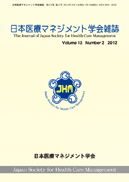Volume 12, Issue 1
Displaying 1-9 of 9 articles from this issue
- |<
- <
- 1
- >
- >|
Case Reports
-
2011Volume 12Issue 1 Pages 2-7
Published: May 01, 2011
Released on J-STAGE: April 13, 2020
Download PDF (1046K) -
2011Volume 12Issue 1 Pages 8-13
Published: May 01, 2011
Released on J-STAGE: April 13, 2020
Download PDF (1570K) -
2011Volume 12Issue 1 Pages 14-18
Published: May 01, 2011
Released on J-STAGE: April 13, 2020
Download PDF (951K) -
Evaluation of the medical safety activities by using a human error management (HEM) self check sheet2011Volume 12Issue 1 Pages 19-24
Published: May 01, 2011
Released on J-STAGE: April 13, 2020
Download PDF (1079K) -
2011Volume 12Issue 1 Pages 25-29
Published: May 01, 2011
Released on J-STAGE: April 13, 2020
Download PDF (814K) -
2011Volume 12Issue 1 Pages 30-34
Published: May 01, 2011
Released on J-STAGE: April 13, 2020
Download PDF (673K) -
2011Volume 12Issue 1 Pages 35-45
Published: May 01, 2011
Released on J-STAGE: April 13, 2020
Download PDF (3665K)
Introductory Reports
-
2011Volume 12Issue 1 Pages 46-51
Published: May 01, 2011
Released on J-STAGE: April 13, 2020
Download PDF (2687K) -
2011Volume 12Issue 1 Pages 52-56
Published: May 01, 2011
Released on J-STAGE: April 13, 2020
Download PDF (539K)
- |<
- <
- 1
- >
- >|
